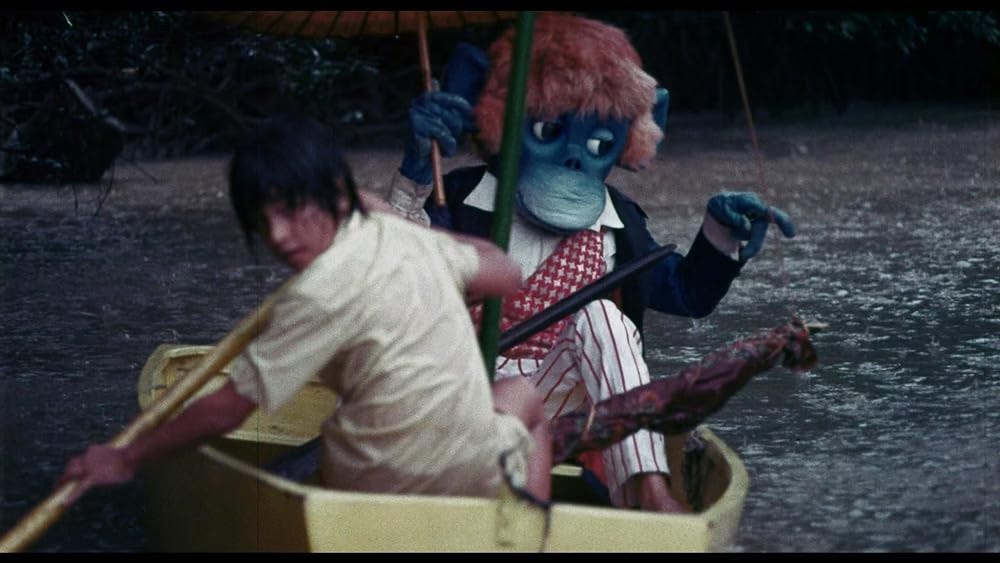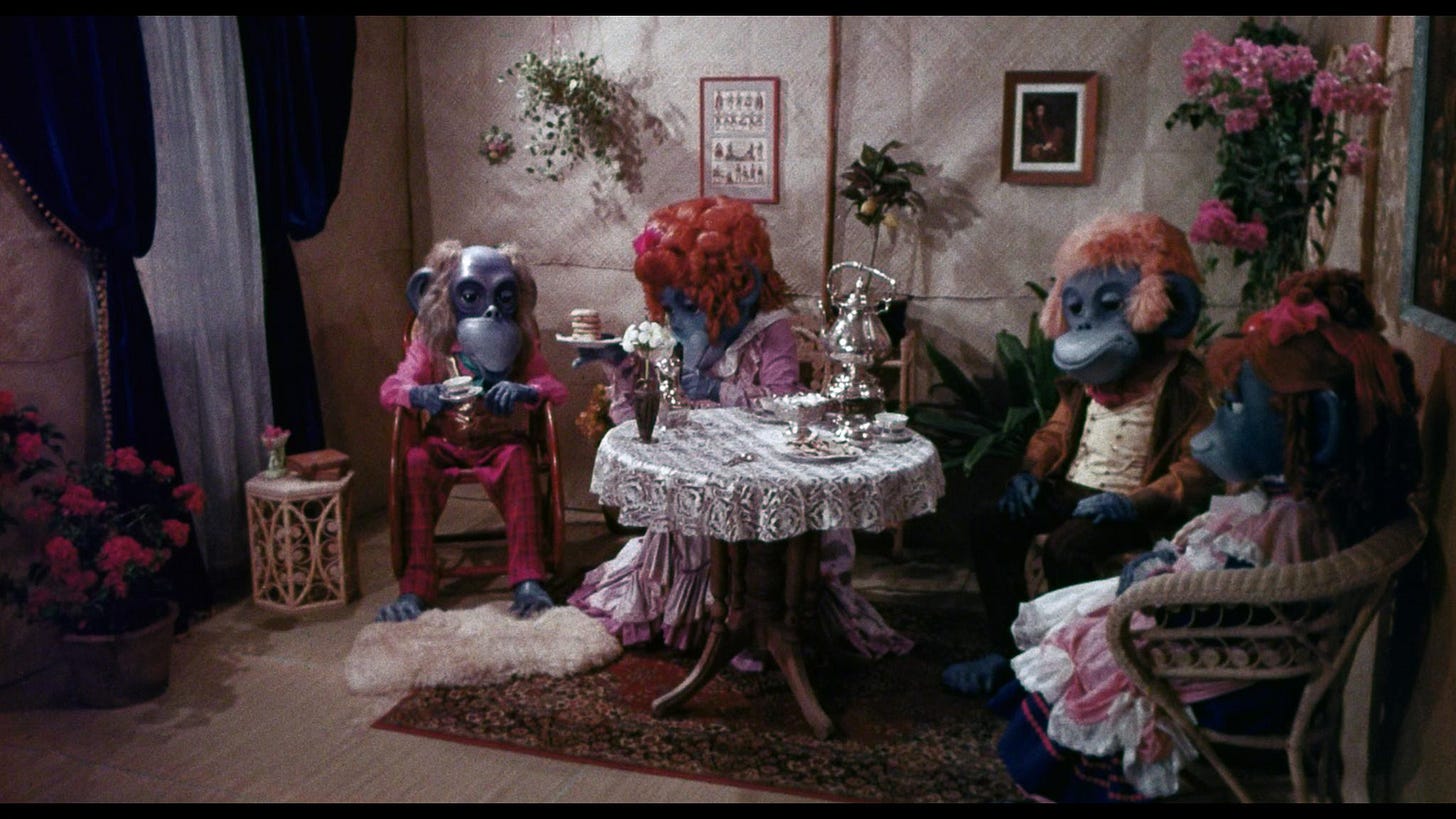Lost Picture Show: The Rare Blue Apes of Cannibal Isle (1975)
The Nostalgia Factor and Children's Films
This is the seventh in a (hopefully) ten-part series on film preservation. Using Vinegar Syndrome’s Lost Picture Show box set as a guide, each post will focus on a different genre and the importance of preserving film history, regardless of how “good” or “bad” we think the films might be. The sixth in the series on Red Midnight can be read here.
Now that I have a son, and as I get older, I’ve been feeling somewhat nostalgic for the films I grew up with. I want to pass on my knowledge of film to him starting with the films I remember enjoying as a kid but I also want to experience new films with him. This means filling in gaps in my childhood and exploring other films that I was maybe unaware of until I got older. I find it strange to me that the makers of these films deem it necessary to throw adults a bone with the inclusion of inuendos and other adult-themed content that goes over the heads of the youths. It is even stranger to me when these films make it such a large part of the film that I start to question who the intended audience of the film is. For example, the 2007 Christmas film Fred Claus seems to be a fun story about Santa Claus’ sketchy brother, but the film's villain is an efficiency expert. Where do you begin to explain what that is to a child? Maybe I am putting too much thought into it where a normal child would just understand Kevin Spacy is the “bad guy” because he is against Santa. Similarly, some films appear to be for children but are so strange you cannot help but wonder if the film was made for kids or your stoner roommate to stumble on a local cable TV channel at one in the morning. This is where The Rare Blue Apes of Cannibal Isle (1975) lives.
Where do I begin with The Rare Blue Apes of Cannibal Isle? It is a musical children’s film directed by someone known for their sexploitation films (Donn Greer) and filmed in Malaysia. The film was distributed under multiple names such as Cap’n Krock and the Rare Blue Apes and Mr. Quack-Quack and the Rare Blue Apes. The film is about a young mute boy, Nonnie (Daud Bin Ibrahim), who runs away with his duck Mr. Quack-Quack after his father tells him Mr. Quack-Quack is a menace to their household and has to go. As he floats away on his boat he stumbles upon ‘Cannibal Isle,’ an Island inhabited on one side by giant alligator/crocodile, pirates called “Swampies,” while the rare blue apes inhabit the other side. As the film progresses, Nonnie, Mr. Quack-Quack, and one of the rare blue apes, Hotcha (Zainal Abidin Bin Abdul Ghani), make their way back from the Swampie side of the island to Hotcha’s family while they are pursued by Captain Krock (Martin De Rozario) and the rest of his weirdly, British pirate gang. Somehow this summary fails to do the film justice.
The film is one of those children’s films so bizarre because of how all of the pieces come together, you do not know if it was the result of insane amounts of drug usage or just a strange attempt to make a film for kids. At one point it is explained that an eagle security guard built a rocket to destroy the Swampie side of the island. The film follows “kid logic” in such a way that they would not care if the things occurring were silly nonsense or not. Adults often view the plot of children’s films as silly nonsense as they involve leaps in logic or multiple deus ex machinas. These are only things adults care about but work in the mind of a child still developing and creating mental connections.
As adults, it can be easy to ignore films made for children due to their silly, childlike, and naive nature. I do. Every year I have to narrow my focus more and more on what films I choose to give my attention to. Hollywood releases dozens of films a year. Independent studios and streamers release dozens of films a year. I am also playing catch up with all of the films originally released before my time thanks to all of the smaller, “boutique” Blu-ray labels like Vinegar Syndrome, Severin, Mondo Macabro, and others. I do not have time to devote to a classification of film. That does not mean these films do not have value. With a child in the house now I have to start tuning my attention toward these films, seeing The Rare Blue Apes of Cannibal Isle reminded me I should not rely on the nostalgia factor to determine what films to show him because there are still countless children’s films in existence I have yet to experience.
The nostalgia factor is a dangerous thing. It is easy to determine the “worth” of a film by our nostalgia for it. This might be the biggest mistake we can make as film fans. Like any other film, they deserve equal attention because they are part of our collective history and can find a new audience outside their time. At the same time, there are plenty of films that have risen to the status of “cult classic” because of nostalgia that do not hold up for some watching for the first time today. This does not just apply to children’s films. How often do we get caught up in the memory of a film we loved from an earlier point in our life that we place it on an untouchable pedestal? Why should a sequel to a film we watched 20+ years ago be made for us today? How could a sequel to a film we watched 20+ years ago live up to the expectations we had for it?
The Rare Blue Apes of Cannibal Isle might be a bizarre acid trip of a film, but it works well as a children’s film. As much fun as it can be sometimes to revisit films from our youth as an adult, we were not the intended audience for these films. Something we often fail to keep in mind when we choose to engage with film. We may have fond memories of a John Goodman voiced, talking dinosaur stomping through New York City and a crazy carnie with a screw for an eye, but that does not necessarily mean the film would impact us the same way as an adult. It was a film made for children after all.
Films like The Rare Blue Apes of Cannibal Isle deserve to be treated with the same care and respect as other films. Especially along with the films in this box set. It is the kind of film that probably would not be made today. Like all the films in this set, it is a product of a specific time and place in history. I have lost track of how many times I have typed that, but it is the one common theme I keep returning to with this set. I see a lot of people claiming this film is the only film worth watching in the entire set and that the rest of the films are disappointing. I would disagree, but I love and appreciate all films (or at least try to). I would not even characterize this film as the strangest of the set. It is unique in that it is a film made for children while the rest of the films are intended for an adult audience. Maybe that is part of what makes this film so much more fun. There is no nostalgia factor for it and as adults, we can take a step back in time and experience the wild ride it is to be a kid again. Nonsense and all.






